Microsoft Surface Pro 3 Review
by Anand Lal Shimpi on June 23, 2014 3:55 AM ESTLaptop Performance
Just like with battery life, we need to evaluate the performance of Surface Pro 3 as both a laptop and a tablet. As a laptop, Surface Pro 3 delivers performance comparable to other Ultrabooks of similar specs - assuming we're talking about short bursts of performance. In prolonged workloads you'll see a bit of a gap, and even a slight regression vs. Surface Pro 2 due to the thermal design targets for the new chassis.
With the exception of the Work suite in PCMark 8 v2, we're mostly looking at performance in the range of a 13-inch MacBook Air - the prototypical Haswell ULT notebook. Surface Pro 3 is definitely in good performance company. In the Work suite however the MacBook Air (running Windows) is able to deliver around 16% better performance than Surface Pro 3. I'm guessing this has to do with thermals more than anything else.

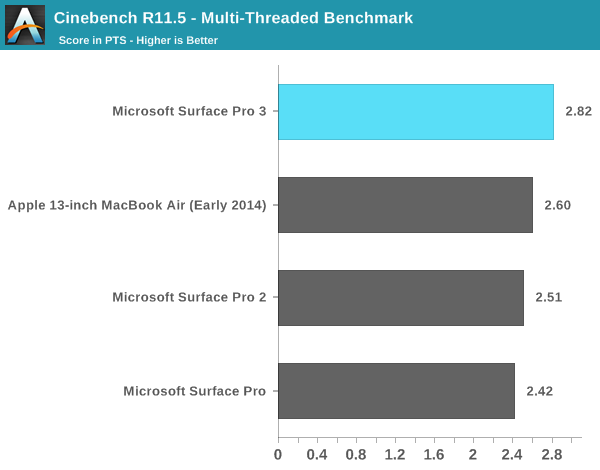
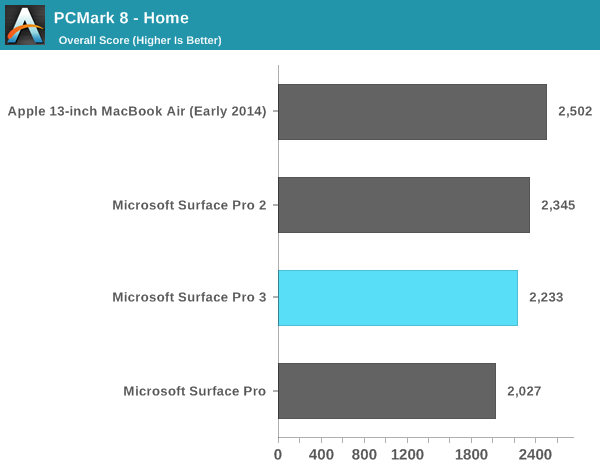

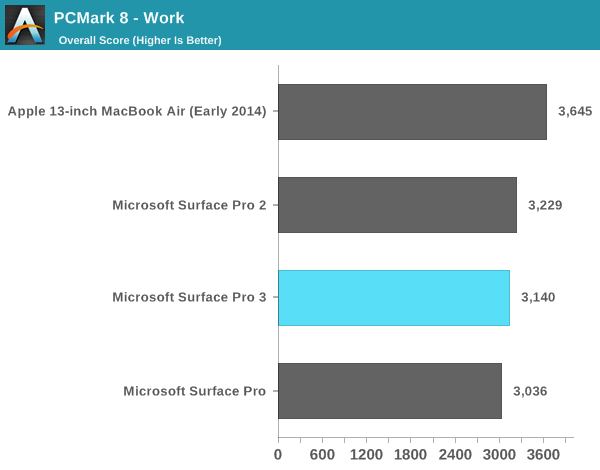

We see a similar story if we look at GPU performance:
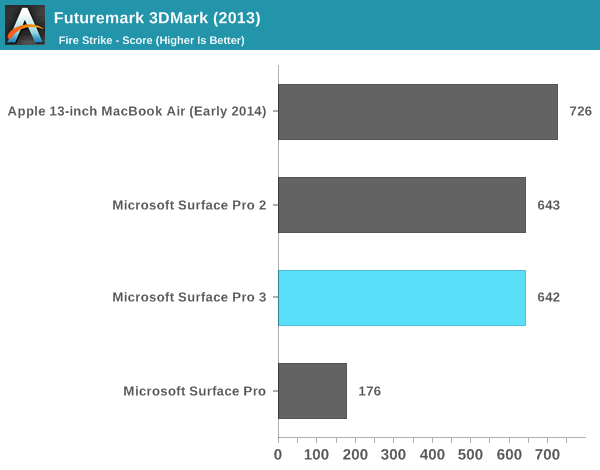
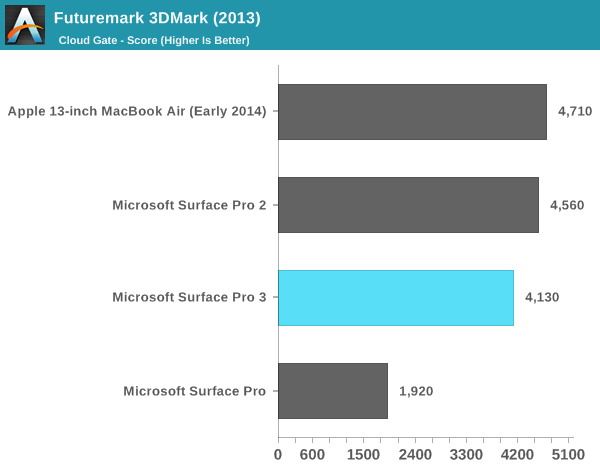
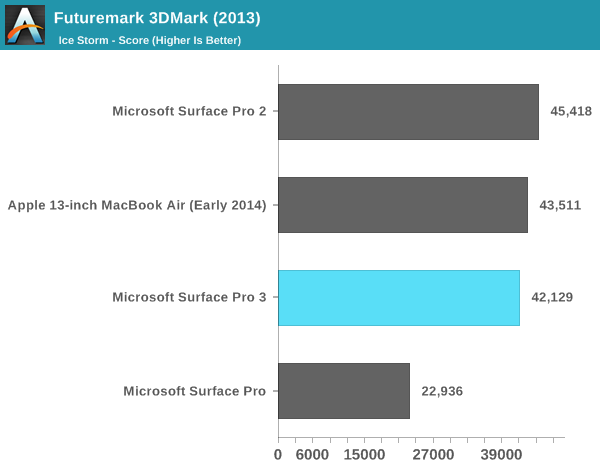
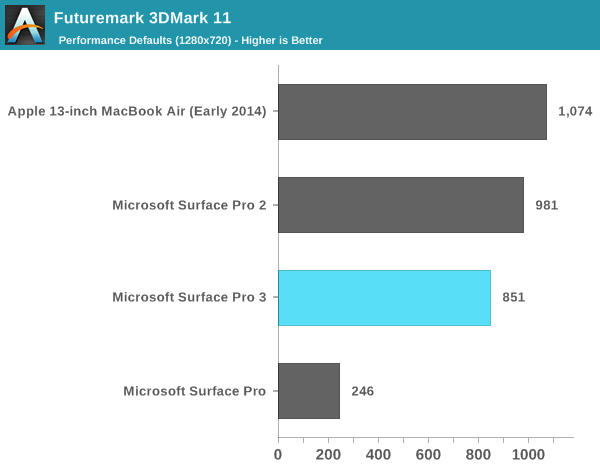
In terms of playable games, with some tweaking to detail settings you should be able to average 30 fps in titles like Dota 2. Running at the panel's native resolution is generally out of the question but for lighter titles on Steam like Transistor, you can have a reasonable experience. The higher end Core i7 Surface Pro 3 does ship with Intel's HD 5000 graphics instead of HD 4400 in the Core i5 review sample I tested. It's entirely possible that we see better gaming performance or thermal management (more EUs at lower voltage) in that design.
Just like in previous designs, Surface Pro 3 integrates a SATA SSD (likely M.2 this time). In this case Microsoft uses an OEM version of Samsung's SSD 840 EVO, a 3-bit-per-cell MLC design that we've found to be a pretty good value. I am disappointed we didn't see a move to PCIe storage but for general use I doubt there's much value in it. PCMark 8 v2's storage test isn't particularly stressful but it does show that Surface Pro 3's SSD is at least competitive with its predecessor and the MBA despite moving to TLC NAND.
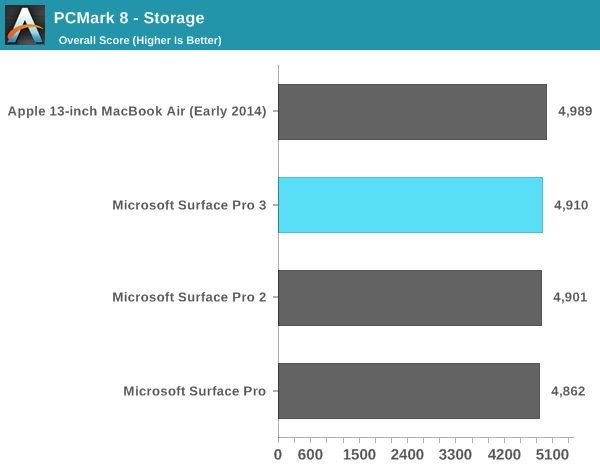










274 Comments
View All Comments
Da W - Monday, June 23, 2014 - link
I use touch on the desktop all the time and it woks well.ablejo26 - Monday, June 23, 2014 - link
You obviously don't know what you are doing on windows 8.1, I switched from mac air with the pro 2 and its way better. If you are not into learning new OS that's fine to stay with the old as it does the job but if want an experience that gives you a touch and type then do it you wont regret it.mmrezaie - Monday, June 23, 2014 - link
Maybe you are right. I am from oss (linux/unix) world, and as far as I am thinking about it, it feels like two distinct os, and not one unified shell. Don't get me wrong, I like the idea very much, but in the end I returned it because I couldn't see it as developer friendly. I use my macbook air a lot since I am always getting remote shell from my servers.basroil - Tuesday, June 24, 2014 - link
"far as I am thinking about it, it feels like two distinct os, and not one unified shell. "In that case you know linux is a schizoid, since bash is completely different to your desktop environment (despite being necessary and also allowing most software to run), and then each desktop environment is different (gnome, KDE, etc). Hell, it's even crazier because you can't actually expect your program to work out of the box on all systems even if they run the same base OS! (mostly because of desktop environment and default packages)
In windows, you have powershell if you need it, and you never NEED to develop for WinRT and Windows.h concurrently.
darwinosx - Tuesday, June 24, 2014 - link
Oh so he's not doing Windows 8.1 the right way...got it.I'll take an Air over the compromised device any day.
kyuu - Tuesday, June 24, 2014 - link
Your Air is a compromised device, as all laptops are. Compromises are made in the name of portability. Calling the SP3 a "compromised" device as though it's some sort of derogatory term is silly. Engineering is all about compromise.Voldenuit - Monday, June 23, 2014 - link
Yeah, $500 to jump to the 8GB/256GB config is pretty steep.$799 for the base model isn't bad, but you're getting severely compromised RAM and storage and a less capable CPU. As Anand says, the type cover needs to be included as standard at all price points, and the higher SKUs are just too expensive for me to stomach (YMMV).
fokka - Monday, June 23, 2014 - link
exactly this. the jump from 256gb to 512gb is $400, while a new 512gb msata evo costs 280 bucks.basroil - Tuesday, June 24, 2014 - link
The 512gb one isn't necessarily an evo, like the 128gb one that sure as hell isn't (hynix unbranded). If they swapped it out for a 840pro or similar I bet you wouldn't be complaining (costs about 400 )tential - Monday, June 23, 2014 - link
I agree with you but this is MSRP launch day prices. Give this a month or two and you'll see much lower prices. I wouldn't be surprised if the model Anand tested for $1299 was $900-1000 In November.